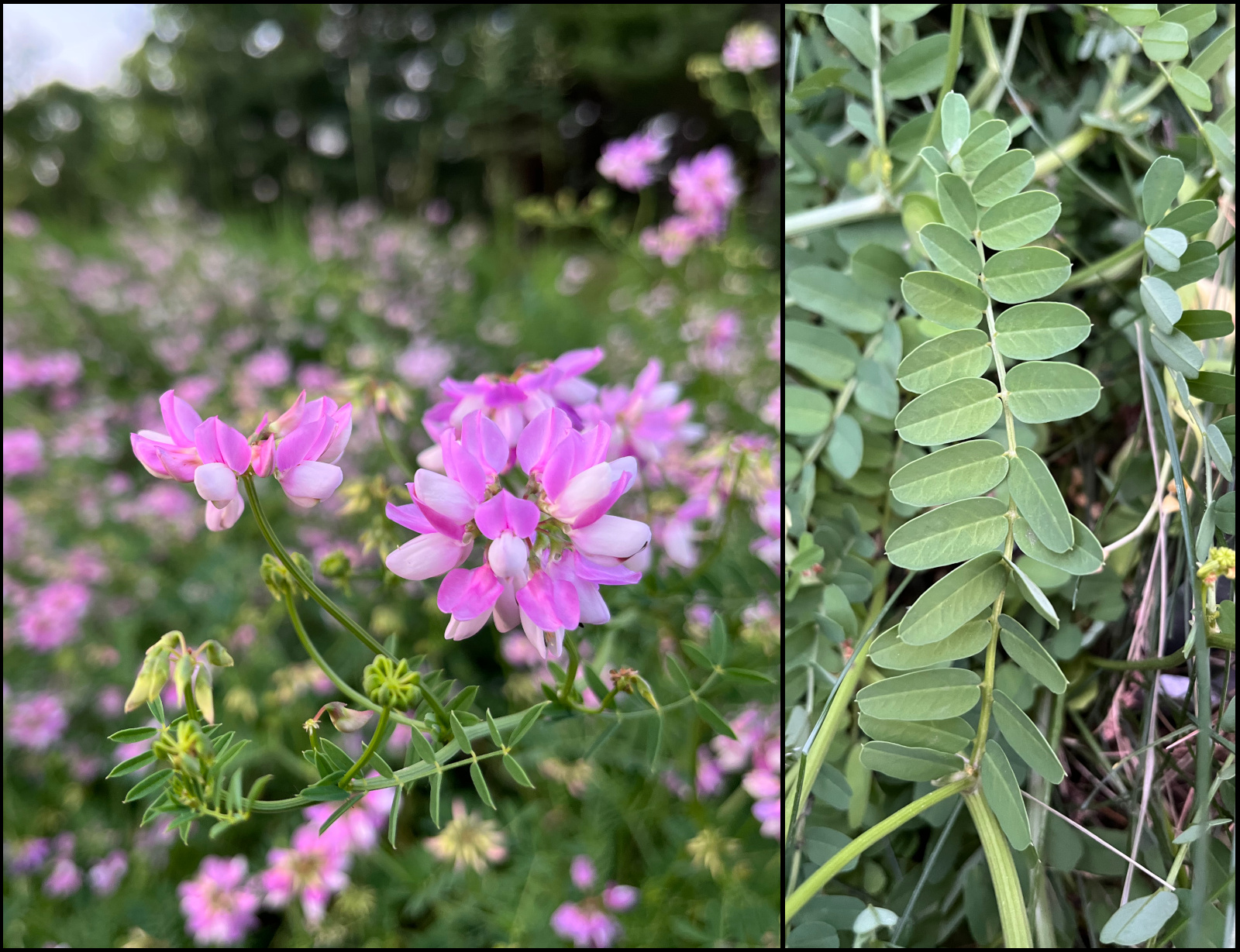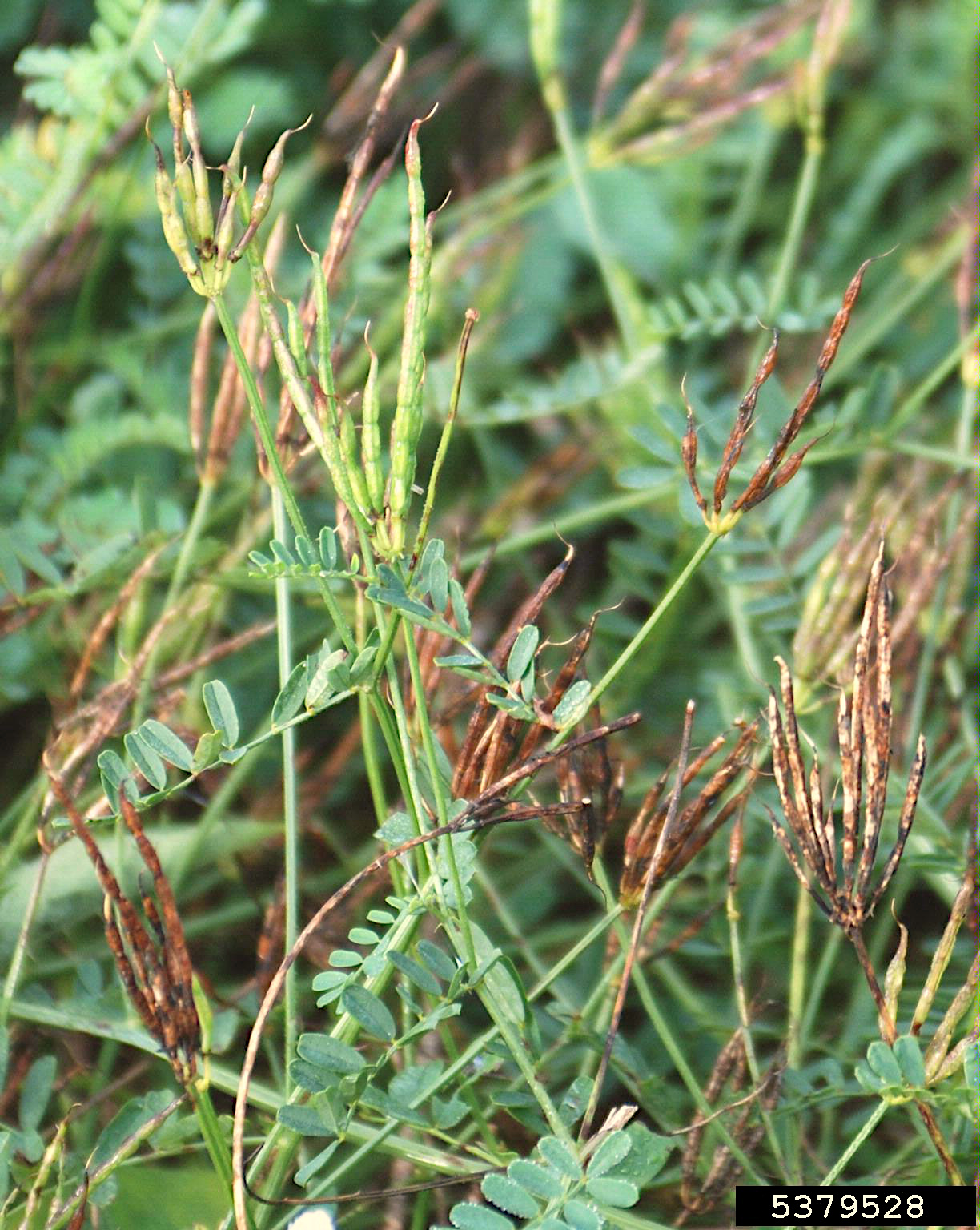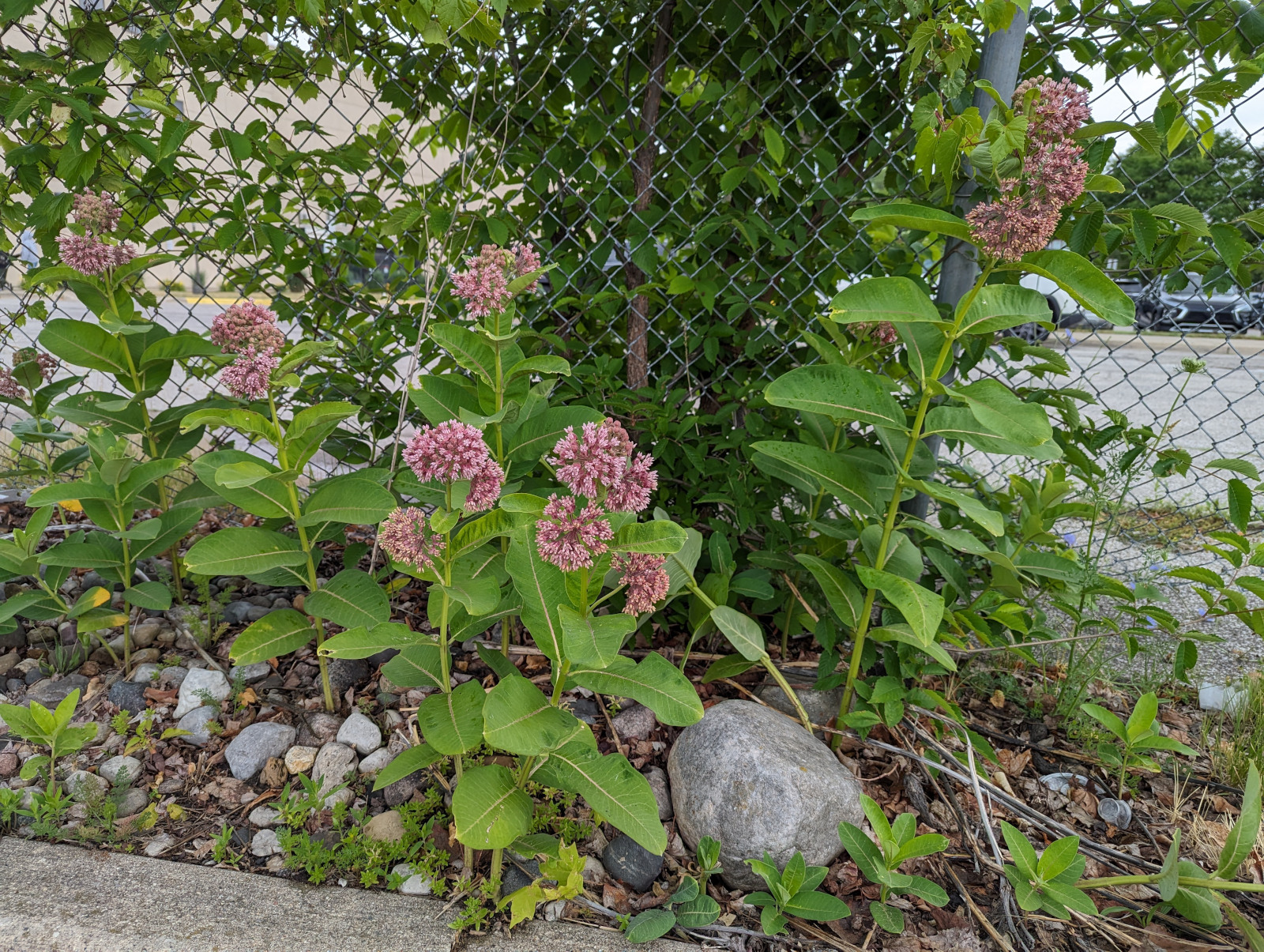Drive-by botany: Crown vetch and common milkweed
Profiles of common Michigan roadside flora in late June 2023.

Authors’ note: Drive-by Botany is a continuing series that highlights flowering plants commonly seen from the road. As a service to new readers, we include the introduction with each article. If you're already familiar with the premise, feel free to skip down to the good stuff.
Has a patch of flowers ever caught your eye as you travelled down the road? It certainly happens to us all the time! As gardeners and naturalists, we're always interested increasing functional diversity in our gardens and landscapes, so we thought it would be fun to consider some of the roadside plants that we see every day. Each article in this series will feature two plant species that are currently blooming and frequently observed from the road. Our goal is to answer two simple questions:
- What are they?
- Would they make good garden plants?
As part of the process, we'll include some biological tidbits and a few useful characteristics for identification. Please note that some of the plants we feature are exotic invasive species; we'll be sure to include recommendations from land management professionals on how to manage them in your landscape.
June 2023 - week 25, 829 growing degree days (GDD) base 50, East Lansing, Michigan
Crown vetch (Securigera varia)
Synonyms: crown-vetch, trailing crownvetch, Coronilla varia
Crown vetch is an herbaceous perennial in the pea family (Fabaceae), the third largest family of plants on Earth. Members of the Fabaceae are often referred to as “legumes” and are famous for their mutually beneficial relationship with bacteria that absorb atmospheric nitrogen and make it available to the plant. In exchange for this vital nutrient, legumes provide these bacteria with a source of energy (sugars) and a favorable living space (root nodules). It's a win-win situation for both organisms and a big reason why many important agronomic and horticultural crops (soybeans, peanuts, alfalfa, clovers, lupins, lentils, etc.) come from the pea family.
Securigera varia originates from Europe, Africa, and Asia, but has been used throughout the world for livestock forage, cover cropping, and erosion control purposes.
Description
Flowers: Crown vetch produces lovely pinkish-purple and white flowers arranged in circular clusters at the end of a lengthy stalk (Photo 2). Individual flowers are approximately 0.5 inches in length and reside at the end of their own short stalks that collectively emanate from a common point (much like an umbrella). Each flower is bilaterally symmetrical and shaped like the prototypical pea blossom with a petal configuration that forms three special structures: the standard (a.k.a. the banner), the wings, and the keel. The standard is the large petal on top, the wings are the two small lateral petals, and the keel consists of the two lower fused petals.

Leaves: Securigera varia has dark green pinnately compound leaves, arranged alternately along the stem (Photo 2). The leaves usually have anywhere from 15 to 30 leaflets.
Terminology: Most plants have leaves with a structure that falls into one of two categories: simple leaves or compound leaves. Simple leaves have a single "blade" that may be lobed, but is undivided. Some examples of plants with simple leaves are maple trees and oak trees. On a compound leaf, the blade is divided into smaller leaflets that are attached to the middle vein. Compound leaves are further divided into two main types:
- Palmately compound: in which the leaflets are all attached to the end of the petiole and radiate outward (e.g. horse chestnut trees).
- Pinnately compound: in which the leaflets are attached at intervals along both sides of the mid rib (e.g. walnut trees, black locust trees, crown vetch)
Seeds/fruit: The slender and segmented fruits of Securigera varia are 2 to 3 inches long, arranged in circular clusters, and are frequently described as having a finger-shaped appearance (Photo 3).

Stem: Crown vetch displays a trailing growth habit, characterized by long stems that typically range from 2 to 4 feet in length.
Distribution: Securigera varia has been documented in 30 Michigan counties, largely in the lower peninsula, but also as far north as Marquette County in the upper peninsula. Due to its initial purpose for erosion control, crown vetch is predominantly found along roadsides, open fields, waste areas, rights-of-way, and gravelly slopes lining streams.
Blooming period: Crown vetch starts flowering in late spring and can sometimes be found blooming as late as August, depending on environmental conditions.
Native status: Exotic/Introduced. This species is not native to the United States. It was first documented in Michigan in 1930 in Oakland County.
Garden uses: Crown vetch demonstrates exceptional resilience, withstanding frigid temperatures as low as -30 degrees Celsius, coping effectively with heavy precipitation, and thriving in variety of soil textures, including sandy, gravely-rocky, loamy, and clayey soil. It performs well on low fertility sites and acidic soils but has limited tolerance for salt and high-pH conditions. While it requires a moderate amount of moisture to thrive, established crown vetch can endure prolonged periods of drought. Consequently, it serves as an excellent choice for stabilizing road banks, particularly in rocky regions.
The characteristics that make it so useful for those purposes, however, also make it a menace to native ecological communities. Once established, the thick foliage crowds out other plants and prevents new ones from germinating within the patch. Its ability to fix atmospheric nitrogen compounds the issue because nitrogen is a primary limiting nutrient in most ecosystems. Research has shown that the introduction of additional amounts of nitrogen into a system can fundamentally change the plant community composition in that area, often encouraging aggressive non-native species.
Opinions on whether we, as a society, should continue using crown vetch are mixed. It's considered an invasive species in many states. However, the USDA National Resource Conservation Service (NRCS), while acknowledging its weediness, still recognizes that Securigera varia can be very helpful in specific situations (i.e. soil stabilization and erosion control). As such, the authors recommend against using crown vetch in any garden setting (formal or otherwise). If employing this species for soil stabilization purposes, we urge caution and advocate for mindful application in conjunction with a management plan that accounts for its invasive tendencies.
For those seeking native or non-invasive alternatives that can help with erosion control, we offer some suggestions:
- Milkweeds (Asclepias)
- Spreading dogbane (Apocynum androsaemifolium)
- Prairie dropseed (Sporobolus heterolepis)
- Lance-leaved loosestrife (Lysimachia lanceolata)
- Little bluestem (Schizachyrium scoparium)
- Purple prairie clover (Dalea purpurea)
- Bearberry (Arctostahylos uva-ursi)
- Virginia creeper (Parthenocissus quinquefolia)
- Goldenrods (Solidago spp.)
- American vetch (Vicia americana)
Other resources to consider:
- For shoreline erosion control: Smart waterfront plants to enhance your shoreline
- A helpful bulletin from Indiana DNR (see page 2): Crown Vetch
- Erosion control in an agricultural context: Eroding away your economic and environmental progress
In nature, we rarely see monocultures. Consider using more than one species for your soil stabilization projects.
Management: The aforementioned bulletin from the Indiana Department of Natural Resources discusses various methods for controlling crown vetch. As always, follow the label when applying any pesticide.
Similar species: Clovers (Trifolium species)
Common milkweed (Asclepias syriaca)
Synonyms: Virginia silk, silkweed, wild cotton, cotton-weed, butterfly flower, others
Common milkweed is a member of the Apocynaceae family. Driving through farmland in early summer, it is often seen blooming in ditches, or along the side of highways. Like many other plants in the family, it is a perennial forb. Its tendency is to quickly spread from rhizomes, forming colonies (Photo 4).

The common name comes from the milky white sap found in the stems, leaves, and flowers.
Quick definition: botanists commonly use the term “forb” to describe herbaceous flowering plants that aren’t grass, sedges, and rushes.
Description
Flowers: Highly fragrant flowers vary in color from pink, to mauve, and, rarely, white. Individual flowers are half an inch in diameter and are grouped together at the end of the growth stem in a spherical cluster (Photos 4 & 5).

Leaves: Leaves are a gray-green color. The simple leaves grow opposite on the stem and are broadly oval- or lance-shaped (Photos 4 & 5). They grow from 4 to 8 inches long and are 1.5 to 5 inches wide at the base, tapering at the tip. The leaves usually exhibit reddish main veins. They have very short petioles (leaf stems) and velvety undersides.
Seeds/fruit: After the flowers are pollinated, common milkweed forms distinctive warty seed pods. The seed pods are horn-shaped and about 4 to 6 inches long. When unripe, they are green, and turn brown and dry when mature. Inside the pods are many seeds, attached to short, white flossy hairs. When fully mature, the seed pod breaks open and the seeds blow away on the wind.
Size: First year plants grow approximately one foot tall, while a mature stand of common milkweed grows between 3 and 6 feet tall.
Distribution: Asclepias syriaca has been documented in almost every county in Michigan. It prefers full sun and can tolerate a wide range of soil conditions but seems to thrive in dry to somewhat moist soils, usually of sandy composition. Thus, it is typically found in open fields, meadows, along roadsides, and other areas of frequent disturbance.
Blooming period: Common milkweed blooms in Michigan in late June or July.
Native status: Native to Michigan. Common milkweed is native to eastern North America, west to Iowa and Kansas.
Garden uses: Common milkweed, with its nectar-rich flowers, is a premier pollinator plant. It supports a diverse suite of herbivorous insects and serves as a vital food source for the monarch butterfly caterpillar. Over the course of more than two decades, researchers and citizen scientists have been tracking monarch populations and their findings reveal a concerning trend: the number of monarch butterflies at overwintering sites has been steadily declining. The population downturn is primarily attributed to habitat loss, exposure to pesticides, and global climate change. Conservation initiatives such as the Monarch Waystation Program focus on creating safe habitat with appropriate breeding sites (i.e. milkweeds) and abundant sources of nectar.
Other insect species commonly seen on A. syriaca are the milkweed tussock moth caterpillar, the red milkweed beetle, and both the large and small milkweed bug. A. syriaca spreads vigorously through rhizomes with a tendency to form large patches that can easily overrun a small garden over the course of a few years. It is, however, a perfect choice for areas where it is allowed run and colonize with competition from other aggressive native species, such as in a meadow or prairie setting. Those that wish to incorporate A. syriaca into a formal garden setting should plan on routinely removing or relocating extra milkweed sprouts. The sap can cause skin irritation for some people and is toxic to humans when ingested. Use of gloves when handling any part of a milkweed plant is recommended.
Note that several municipalities in Michigan have ordinances restricting or prohibiting growing common milkweed on properties. Check your local code before planting in your yard or garden.
Common look-alikes: Hemp dogbane (Apocynum cannabinum), which is also strongly clonal. Common milkweed may also be confused with other species in the genus Asclepias, such as purple milkweed (Asclepias purpurascens) or swamp milkweed (Asclepias incarnata). However, both purple milkweed and swamp milkweed flowers are richer in color, the leaves are narrower and more bright green, and seedpods are held upright and are smooth.
Want more Drive-by Botany? Check out some of our previous roadside adventures!
Questions? Feel free to contact Jeremy Jubenville or Lindsey Kerr with the MSU Extension landscape team.
Thank you to Tyler Bassett from the Michigan Natural Features Inventory for his review of this article.
Resources:
- Michigan Flora (2001) – E. Voss
- USDA PLANTS Database - Securigera varia (plants.usda.gov)
- Weeds of the Northeast (1997) – Uva, Neal, and DiTomaso



 Print
Print Email
Email





